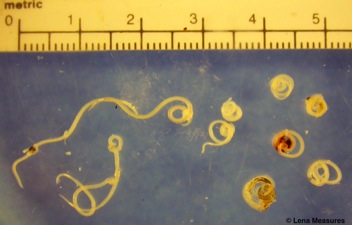Anisakis spp.
Contributor: Lena Measures
Biology: Anisakis spp. (or more commonly whaleworm) are roundworms or nematodes that parasitize whales. At least nine species have been described.
Life cycle: The widely distributed species, Anisakis simplex, reproduces in the stomach of whales such as beluga or minke whale (Fig. 1). Female worms produce eggs (Figure 2) which enter the sea with the faeces of the whale. A period of development is required in the sea before larvae hatch from eggs. These larvae are then eaten by a first intermediate host, such as krill which are pelagic shrimp-like crustaceans. Infected krill are subsequently eaten by a transport host, such as squid or small pelagic fish such as capelin, mackerel, herring. These infected fish or squid are in turn eaten by large pelagic predatory fish, such as redfish, salmon or silver hake which can accumulate large numbers of larvae. Finally the life cycle is completed when the definitive or final host, such as a minke whale eats infected fish or more directly by eating infected krill.

Figure 1. Adult Anisakis simplex in pilot whale stomach.

Figure 2. Life cycle of Anisakis simplex and Pseudoterranova decipiens (Source: CDC).
Transmission: Larval stages in fish are small (10 to 35 mm long) and are usually found in a flat coil on the visceral organs (Figs. 3, 4). Larvae may migrate into fish flesh if fish are not kept on ice or not quickly eviscerated immediately after capture. Larvae in fish flesh are difficult to see because they are colorless or white in color.

Figure 3. Larval Anisakis simplex (arrows) in abdominal cavity of Atlantic herring.

Figure 4. Larval Anisakis simplex removed from Atlantic herring.
Prevalence: Anisakis spp. are reported widely in marine fish, squid and whales throughout the world’s oceans. In Canada whaleworm is found in commercially important fish such as capelin, mackerel, herring, redfish, hake and salmon as well as alewife, American plaice and other flatfish species, smelt, haddock, tomcod, Atlantic cod, pollock, etc. Prevalence is greatest in pelagic fish and up to 100% of some species such as herring may be infected with dozens of infective larvae.
Susceptible populations: Humans and other non-definitive hosts are accidentally infected by ingesting infected fish or squid. As Anisakis spp. do not mature and reproduce in humans or other non-definitive hosts they may be considered as dead-end hosts even though they are susceptible to infection. Infection with whaleworm is called anisakiosis, and can be a serious illness in humans. This occurs more frequently in Japan, where fresh raw fish such as "sashimi" and sushi are delicacies. To date 3 cases of anisakiosis have been reported in Canada but 2,000 cases are reported annually in Japan.
Symptoms: Many human cases of anisakiosis likely go unreported, and probably many worms die or are passed in the faeces without causing any symptoms or clinical signs. Diagnosis is difficult, but clinical infections are usually suspected based on symptoms, clinical presentation, and history of recent consumption of improperly prepared seafood. Symptoms in intestinal anisakiosis which is the more common presentation includes low abdominal pain, particularly in the lower right quadrant, nausea, vomiting, fever, diarrhea or constipation, and occult blood in the stool usually within 1 to 7 days after consuming infected fish or squid.
Treatment: In clinical cases of intestinal anisakiosis, symptoms often diminish with conservative treatment, no anti-parasitic drugs are available. Sometimes emergency surgery is performed as illness is often misdiagnosed as appendicitis or other abdominal illness. During this surgery worms may be found and physically removed.
Control measures: Whaleworm is remarkably resistant to various environmental conditions. In fish flesh it can survive cold smoking up to 40°C, insufficient marination or salting and freezing temperatures down to -20°C for 4 to 5 days. Deep-freezing of fish (at least 24 hours at -30°C) and cooking (at least 5 minutes at 60°C) will kill larvae. There is regular testing in federally regulated fish processing plants in Canada using the candling method.